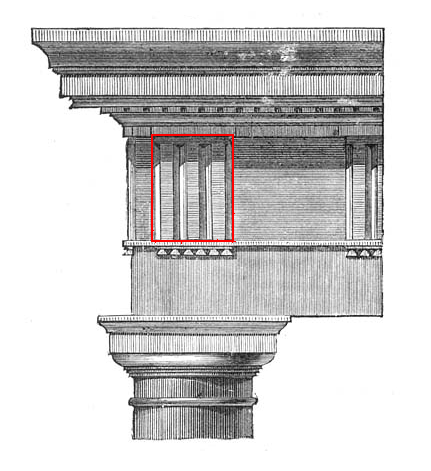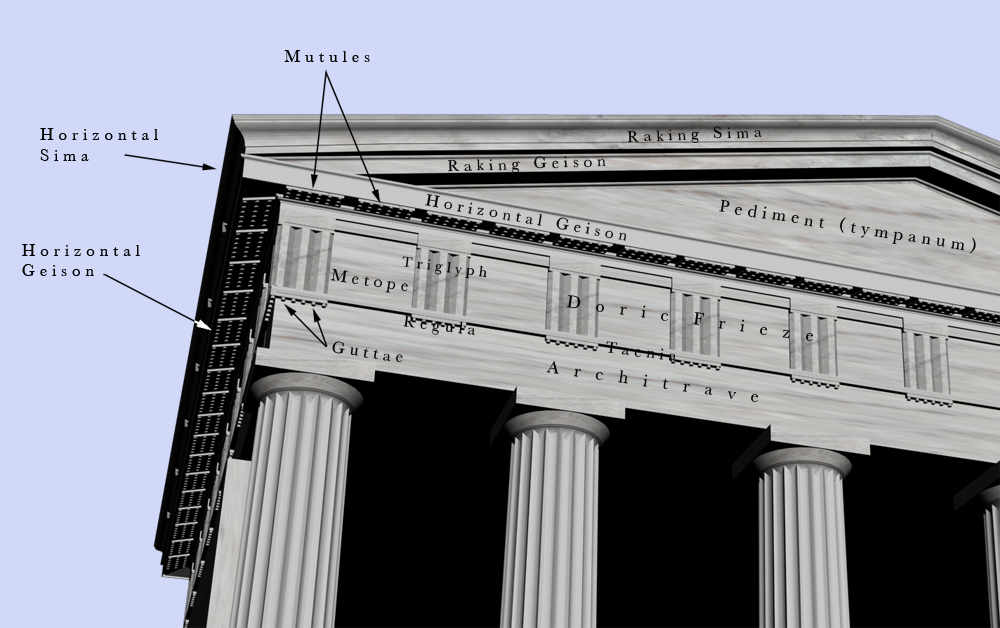|
Taenia (architecture)
In classical architecture, a taenia (, ) is a small "Fillet (mechanics), fillet" molding (decorative), molding near the top of the architrave in a Doric order, Doric column. The entire structure above the columns is called the entablature. It is commonly divided into the architrave, directly above the columns; the frieze, a strip with no horizontal molding, which is ornament (architecture), ornamented in all but the Tuscan order; and the cornice, the projecting and protective member at the top. The architrave, the lowest band, is split from bottom to top into the broad Fascia (architecture), fascia, the guttae or "drips" (below the triglyph in the frieze), and the ''taenia'' (below the projecting cymatium). See also * Classical order * Roman architecture Notes References * Image: :Image:Table of architecture, Cyclopaedia, 1728, volume 1.jpg, Table of architecture, Cyclopaedia, 1728, volume 1 Columns and entablature Ancient Roman architectural elements {{architecturale ... [...More Info...] [...Related Items...] OR: [Wikipedia] [Google] [Baidu] |
Tuscan Order
The Tuscan order (Latin ''Ordo Tuscanicus'' or ''Ordo Tuscanus'', with the meaning of Etruscan order) is one of the two classical orders developed by the Romans, the other being the composite order. It is influenced by the Doric order, but with un- fluted columns and a simpler entablature with no triglyphs or guttae. While relatively simple columns with round capitals had been part of the vernacular architecture of Italy and much of Europe since at least Etruscan architecture, the Romans did not consider this style to be a distinct architectural order (for example, the Roman architect Vitruvius did not include it alongside his descriptions of the Greek Doric, Ionic, and Corinthian orders). Its classification as a separate formal order is first mentioned in Isidore of Seville's 6th-century '' Etymologiae'' and refined during the Italian Renaissance. Sebastiano Serlio described five orders including a "Tuscan order", "the solidest and least ornate", in his fourth book of ... [...More Info...] [...Related Items...] OR: [Wikipedia] [Google] [Baidu] |
Roman Architecture
Ancient Roman architecture adopted the external language of classical ancient Greek architecture for the purposes of the ancient Romans, but was different from Greek buildings, becoming a new architectural style. The two styles are often considered one body of classical architecture. Roman architecture flourished in the Roman Republic and to an even greater extent under the Empire, when the great majority of surviving buildings were constructed. It used new materials, particularly Roman concrete, and newer technologies such as the arch and the dome to make buildings that were typically strong and well engineered. Large numbers remain in some form across the former empire, sometimes complete and still in use today. Roman architecture covers the period from the establishment of the Roman Republic in 509 BC to about the 4th century AD, after which it becomes reclassified as Late Antique or Byzantine architecture. Few substantial examples survive from before about 100 BC, and ... [...More Info...] [...Related Items...] OR: [Wikipedia] [Google] [Baidu] |
Classical Order
An order in architecture is a certain assemblage of parts subject to uniform established proportions, regulated by the office that each part has to perform. Coming down to the present from Ancient Greece, Ancient Greek and Ancient Roman civilization, the architectural orders are the styles of classical architecture, each distinguished by its proportions and characteristic profiles and details, and most readily recognizable by the type of column employed. The three orders of architecture—the Doric order, Doric, Ionic order, Ionic, and Corinthian order, Corinthian—originated in Greece. To these the Romans added, in practice if not in name, the Tuscan order, Tuscan, which they made simpler than Doric, and the Composite order, Composite, which was more ornamental than the Corinthian. The architectural order of a classical building is akin to the Musical mode, mode or Key (music), key of classical music; the grammar or rhetoric of a written composition. It is established by certai ... [...More Info...] [...Related Items...] OR: [Wikipedia] [Google] [Baidu] |
Cymatium
Cymatium (from Greek κυμάτιον "small wave"), the uppermost molding at the top of the cornice in the classical order, is made of the s-shaped cyma molding (either ''cyma recta'' or ''cyma reversa''), combining a concave cavetto with a convex ovolo. It is characteristic of Ionic columns and can appear as part of the entablature, the epistyle or architrave, which is the lintel or beam that rests on the capitals of columns, and the capital itself. Often the cymatium is decorated with a palmette or egg-and-dart ornament on the surface of the molding. The heights of the parts of the capital are to be so regulated that three of the nine parts and a half, into which it was divided, lie below the level of the astragal on the top of the shaft. The remaining parts are for the cymatium, abacus, and channel. The projection of the cymatium beyond the abacus is not to be greater than the size of the diameter of the eye f the voluteIn the case of a concave-convex profile, a disti ... [...More Info...] [...Related Items...] OR: [Wikipedia] [Google] [Baidu] |
Triglyph
Triglyph is an architectural term for the vertically channeled tablets of the Doric frieze in classical architecture, so called because of the angular channels in them. The rectangular recessed spaces between the triglyphs on a Doric frieze are called metopes. The raised spaces between the channels themselves (within a triglyph) are called ''femur'' in Latin or ''meros'' in Greek. In the strict tradition of classical architecture, a set of guttae, the six triangular "pegs" below, always go with a triglyph above (and vice versa), and the pair of features are only found in entablatures of buildings using the Doric order. The absence of the pair effectively converts a building from being in the Doric order to being in the Tuscan order. The triglyph is largely thought to be a tectonic and skeuomorphic representation in stone of the wooden beam ends of the typical primitive hut, as described by Vitruvius and Renaissance writers. The wooden beams were notched in three separate p ... [...More Info...] [...Related Items...] OR: [Wikipedia] [Google] [Baidu] |
Guttae
A gutta (Latin pl. guttae, "drops") is a small water-repelling, cone-shaped projection used near the top of the architrave of the Doric order in classical architecture. At the top of the architrave blocks, a row of six ''guttae'' below the narrow projection of the taenia (fillet) formed an element called a regula. A ''regula'' was aligned under each triglyph of the Doric frieze. In addition, the underside of the projecting geison above the frieze had rectangular protrusions termed '' mutules'' that each had three rows of six ''guttae''. These mutules were aligned above each triglyph and each metope. It is thought that the guttae were a skeuomorphic representation of the pegs used in the construction of the wooden structures that preceded the familiar Greek architecture in stone. However, they have some functionality, as water drips over the edges, away from the edge of the building. Outside the Doric In the strict tradition of classical architecture, a set of guttae al ... [...More Info...] [...Related Items...] OR: [Wikipedia] [Google] [Baidu] |
Fascia (architecture)
Fascia () is an architectural term for a vertical frieze or band under a roof edge, or which forms the outer surface of a cornice, visible to an observer. Typically consisting of a wooden board, unplasticized PVC (uPVC), or non-corrosive sheet metal, many of the non-domestic fascias made of stone form an ornately carved or pieced together cornice, in which case the term fascia is rarely used. The word fascia derives from Latin ''fascia'' meaning "band, bandage, ribbon, swathe". The term is also used, although less commonly, for other such band-like surfaces like a wide, flat trim strip around a doorway, different and separate from the wall surface. The horizontal "fascia board" which caps the end of rafters outside a building may be used to hold the rain gutter. The finished surface below the fascia and rafters is called the soffit or eave. In classical architecture, the fascia is the plain, wide band (or bands) that make up the architrave section of the entablature, dire ... [...More Info...] [...Related Items...] OR: [Wikipedia] [Google] [Baidu] |
Cornice
In architecture, a cornice (from the Italian ''cornice'' meaning "ledge") is generally any horizontal decorative Moulding (decorative), moulding that crowns a building or furniture element—for example, the cornice over a door or window, around the top edge of a pedestal, or along the top of an interior wall. A simple cornice may be formed with a crown, as in crown moulding atop an interior wall or above kitchen cabinets or a bookcase. A projecting cornice on a building has the function of throwing rainwater free of its walls. In residential building practice, this function is handled by projecting gable ends, roof eaves, and rain gutter, gutters. However, house eaves may also be called "cornices" if they are finished with decorative moulding. In this sense, while most cornices are also eaves (overhanging the sides of the building), not all eaves are usually considered cornices. Eaves are primarily functional and not necessarily decorative, while cornices have a decorative a ... [...More Info...] [...Related Items...] OR: [Wikipedia] [Google] [Baidu] |
Ornament (architecture)
An ornament is something used for decoration. Ornament may also refer to: Decoration *Ornament (art), any purely decorative element in architecture and the decorative arts * Ornamental turning * Biological ornament, a characteristic of animals that appear to serve only a decorative purpose *Bronze and brass ornamental work, decorative work that dates back to antiquity * Christmas ornament, a decoration used to festoon a Christmas tree *Dingbat, decorations in typography * Garden ornament, a decoration in a garden, landscape, or park * Hood ornament, a decoration on the hood of an automobile * Lawn ornament, a decoration in a grassy area *Ornamental plant, a decorative plant * Peak ornament, a decoration under the peak of the eaves of a gabled building Music * Ornament (music), a flourish that serves to decorate music *Ornament, a Russian band, forerunner to the band Kukuruza Other uses * Ornament (football), the football team from Hong Kong *Ornaments Rubric, a prayer of the ... [...More Info...] [...Related Items...] OR: [Wikipedia] [Google] [Baidu] |





